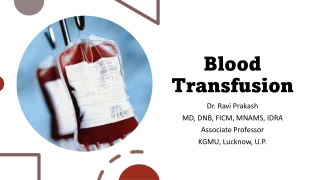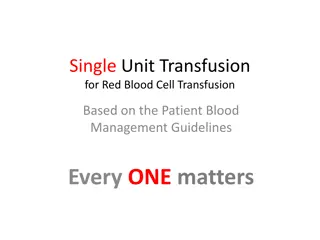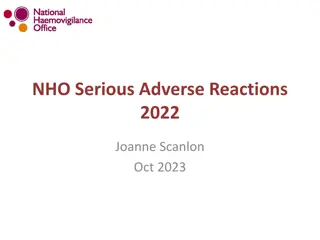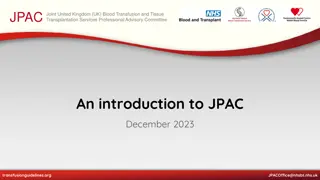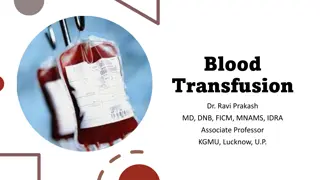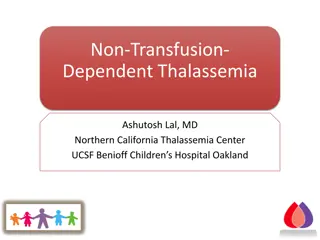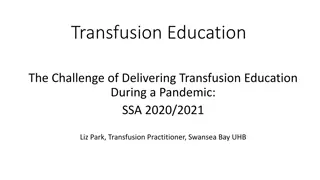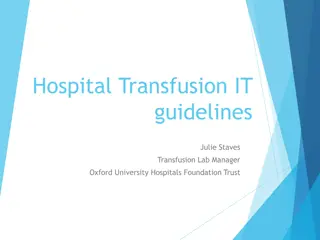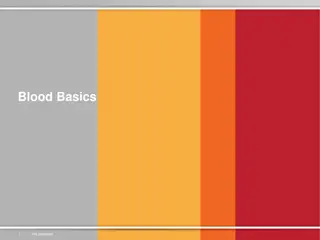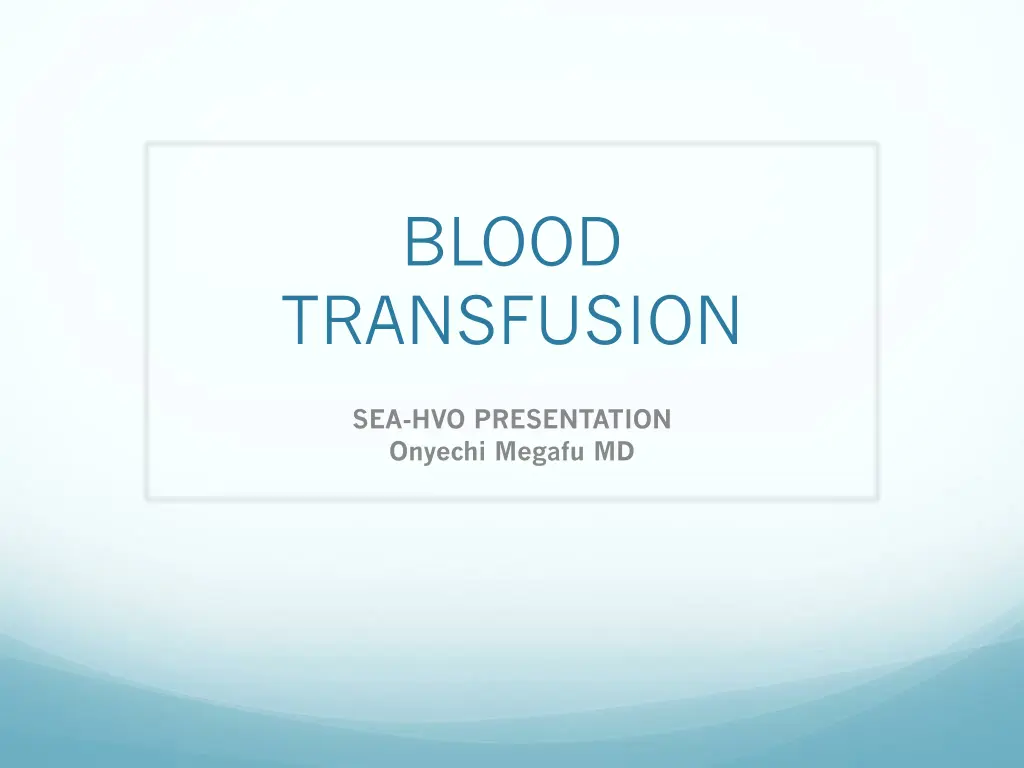
Understanding Blood Transfusion Essentials
Learn about the different types of blood transfusions, reasons for transfusion, when to transfuse, complications, treatment, and transfusion guidelines. Explore the importance of compatibility testing and major blood groups in transfusion procedures.
Uploaded on | 1 Views
Download Presentation

Please find below an Image/Link to download the presentation.
The content on the website is provided AS IS for your information and personal use only. It may not be sold, licensed, or shared on other websites without obtaining consent from the author. If you encounter any issues during the download, it is possible that the publisher has removed the file from their server.
You are allowed to download the files provided on this website for personal or commercial use, subject to the condition that they are used lawfully. All files are the property of their respective owners.
The content on the website is provided AS IS for your information and personal use only. It may not be sold, licensed, or shared on other websites without obtaining consent from the author.
E N D
Presentation Transcript
BLOOD TRANSFUSION SEA-HVO PRESENTATION Onyechi Megafu MD
Blood Transfusion could be: 1.AUTOLOGOUS: collecting and re-infusing of a patient s own blood or blood components 2. HOMOLOGOUS (ALLOGENIC): collecting and infusing the blood of a compatible donor into another of same species 3. HETEROLOGOUS: collecting and infusing blood from a different species
Points of Discussion Why do we transfuse? When do we transfuse? How do we transfuse? What do we transfuse? What can go wrong with blood transfusion? How do we treat blood transfusion complications?
Why do we Transfuse? To fix inadequate oxygen-carrying capacity/delivery To correct coagulation deficits
When do we transfuse? The decision to transfuse should be based on: 1. Monitoring for blood loss 2. Monitoring for inadequate perfusion and oxygenation of vital organs 3. Monitoring for transfusion indicators like hemoglobin concentration NB: These indications are applicable throughout the perioperative period
Transfusion Guidelines The threshold for blood transfusion is often guided by the practice guideline endorsed by an institution. The decision to transfuse should always take comorbidity and the clinical picture into consideration. American Association of Blood Bank Practice Guideline Hb<6 transfuse except in exceptional circumstances Hb 6-7 usually transfuse Hb 7-8 consider transfusion if positive for cardiac disease undergoing cardiac or orthopedic surgery Hb 8-10 generally don t transfuse unless ongoing bleeding, acute coronary syndrome, symptomatic anemia Hb10 or > rarely transfuse
How do we transfuse? Prior to transfusion a compatibility testing is required except in emergencies when there is a risk of exsanguination, in which case a type O Rh-negative (universal blood) is transfused. Compatibility testing is done to predict and prevent antigen-antibody reactions as a result of blood transfusion. The donor and recipient blood are typed and checked for the presence of adverse antibodies
Major blood groups 1. ABO system: Most individuals fall into one of the four types in the ABO grouping system; Type A (Anti-B antibody in serum) Type B (anti-A antibody in serum) Type AB (No anti-A and Anti-B antibodies in serum/universal recipient) Type O (Anti-A and Anti-B antibodies in serum/ universal donor)
Major blood groups 2. Rhesus system: Individuals are either Rhesus positive(Rh+) or negative(Rh-) depending on the presence or absence of the D antigen respectively 3. Other less common blood group systems include Kell, Kidd, Duffy and S. Blood group systems such as lutheran, Sid, Lewis etc. rarely cause transfusion reactions.
Different Compatibility tests 1. ABO-Rh Testing: The patient s red cells are tested with serum known to have antibodies against A and B antigens to determine blood type. This blood type is confirmed by testing the patient s serum against red cells with a known antigen type. The patient s red cells are also tested with anti-D antibodies to determine Rh status. If Rh negative, the presence of anti-D antibody is excluded by mixing the patient s serum with Rh-positive red cells. This is important because the probability of developing anti- D antibodies after a single exposure to Rh antigen is 50-70%
2. Antibody screening: Routinely done on all donor blood. It involves mixing the subject s serum with red cells of known antigenic composition. This is an indirect coombs test and requires addition of antiglobulin antibody to the mixture which will produce red cell agglutination in the presence of specific antibodies. 3. Crossmatching: This involves mixing donor cells with recipient s serum. The purpose is to confirm ABO-Rh typing, detect both antibodies to less common blood group systems and antibodies in low titer or those that do not agglutinate easily
Type &Screen Versus Type &Cross-match Generally whenever the probability of transfusion is high especially for an elective case, type and cross- match is preferred. The incidence of a serious hemolytic reaction after transfusion of an ABO-Rh compatible, negative screen blood product is <1%
What do we transfuse? Blood products are commonly preserved at the blood bank using preservative-anticoagulants. A common solution used is CPDA-1 which contains citrate as an anticoagulant, phosphate as a buffer, dextrose as a red cell energy source and adenine as a precursor for ATP synthesis and prolongation of shelf life (35 days). Commonly transfused products are; Packed Red Blood Cells (PRBC), Fresh Frozen Plasma (FFP), Platelets and Cryoprecipitate.
What can go wrong with blood transfusion? Complications from blood transfusion are either due to the process or product being transfused. It can be divided into three: Immune Complications Infectious Complications Massive transfusion related complications
Immune Complications 1. Hemolytic Reactions: Involves specific destruction of transfused red blood cells by recipient s antibodies. Less commonly caused by hemolysis of recipient s red blood cells by transfused red cell antibodies. This can be acute or delayed.
A. Acute Hemolytic Reactions Occurs in 1:38,000 transfusions Usually due to ABO incompatibility Often severe and can occur after infusion of as little as 10-15ml of ABO- incompatible blood Symptoms and signs include; fever, chills, nausea, chest and flank pain in awake patients. Unexplained hypotension, tachycardia, rise in temperature, diffuse oozing and hemoglobinuria in anesthetized patients. Rx: Stop transfusion, recheck unit and patient identity, draw blood for a repeat of compatibility testing, coagulation studies and platelets count, place a urine catheter to check for hemoglobinuria, start osmotic diuresis with mannitol or IV furosemide and intravenous fluids (UOP>1ml/kg). If blood loss is rapid give platelets and FFP .
B. Delayed Hemolytic Reaction Occurs in approximately 1: 12,000 Usually caused by antibodies to non-D Rh antigens or other non-ABO blood systems eg. Duffy, kell etc. Seen 2-21 days after transfusion Symptoms are generally mild consisting of malaise, jaundice, fever and failure of hematocrit to rise in spite of transfusion and absence of bleeding Rx: Primarily supportive
2. Immune Non-hemolytic Complications A. Febrile Reactions Occur in 1-3% of transfusions Caused by interaction between recipient antibodies and antigens on donor s leucocytes and platelets Characterized by increase in temperature +/- hyper/hypotension without evidence of hemolysis Rx: Transfusion of leukoreduced red cell in patients with a history of repeated febrile reactions, use of anti-pyretic like Acetaminophen
B. Urticarial Reactions Occurs in 1% of transfusions Caused by sensitization of patient to transfused plasma proteins. Characterized by erythema, hives, itching without fever Rx: Antihistaminic drugs (H1 and H2 blockers) and steroids
C. Anaphylactic Reactions Occurs in 1: 150,000 transfusions Typically in IgA-deficient patients with anti-IgA antibodies who receive IgA-containing blood transfusions. Characterized by hypotension, wheezing (bronchospasm),shortness of breath, vomiting, diarrhea, abdominal cramping, hives, itching Rx: Epinephrine, Fluids, Antihistaminic drugs, Steroids and transfusion of washed packed red cells(IgA free blood unit)
D. Transfusion-Related Acute Lung Injury (TRALI) Occurs in less than 1:10,000 transfusion Caused by transfusion of anti-leukocytic antibodies that interact with and cause the patient s white cells to aggregate in the pulmonary circulation. Similar presentation like acute respiratory distress syndrome. Sudden onset dysnea, hypoxemia, hypotension +/- fever, pulmonary edema/diffuse infiltrates on CXR Rx: Typically resolves within 48 hours with supportive care. Oxygen supplementation, aggressive respiratory and cardiovascular system support with IV fluids & vasopressors.
E. Graft-Versus-Host Disease Seen in immune-compromised patients Caused by blood products containing lympocytes capable of mounting an immune response against compromised recipient (host) Prevention is by use of irradiated cellular blood products like red cell, platelet and granulocytes for transfusion to immune-compromised patients-which inactivates lymphocytes without altering the efficacy of product.
F . Post-transfusion Purpura This is a rare state of profound thrombocytopenia following blood transfusion Caused by development of platelet alloantibodies that destroy the patient s own platelets. Characterized by a precipitous drop in platelet count 1 week after transfusion Rx: Plasmapharesis
G. Immune Suppression Rare transfusion complication Thought to be caused by transfusion of leucocyte- containing blood product (immunosuppressive) Prevention: There is no consensus on this but removing white blood cells (leukoreduction) from blood products appears to be increasingly common
Infectious Complications 1. Viral Infections A. Hepatitis The incidence of hepatitis following blood transfusion has dropped significantly since routine testing for hepatitis was implemented. Hepatitis C is mostly implicated. Most cases are anicteric, some will develop chronic liver disease/ Cirrhosis Incidence of post-transfusion Hepatitis is between 1:63,000 and 1: 1,600,000 Rx: Pre-screening of blood for prevention/ Anti-viral therapy
B. HIV/AIDS Risk of transfusion-transmitted HIV is 1: 1,900,000 Characterized by symptoms and signs of immune suppression like recurrent bacterial infections, fungal infections, vomiting, diarrhea, cough, skin lesions etc. Prevention is by pre-screening of blood products for transfusion/ Anti-Retroviral regimen for HIV infection
C. Other Viral Infections Cytomegalovirus (CMV), Epstein-Barr virus and Human T- cell lymphotropic viruses: Usually asymptomatic or mild systemic illness Immunocompromised and immunosuppressed patients are particularly susceptible to severe CMV infections through transfusions Prevention: Transfusion with leucocyte-reduced blood products or CMV-negative units for immunocompromised patients like premature infants or organ transplant recipients
2. Parasitic Infections This is a rare complication Includes parasitic diseases like; Malaria Toxoplasmosis Chagas disease Rx: Anti-parasitic agents
3. Bacterial Infections The prevalence of sepsis due to blood transfusion ranges from 1/25,000 for platelet product to 1/250,000 for PRBC. Infections like syphilis, brucellosis, salmonellosis etc. can be transmitted Prevention: Transfuse blood products over a period <4hours, pre-screening of product, use of broad- spectrum antibiotics when diagnosed
Suspected Transfusion reaction? Stop Transfusion! Keep IV N/S going Document time of onset of symptoms/signs Does the patient have fever? Yes: consider TRALI, AHTR, Sepsis or FNHTR No: consider Anaphylaxis, urticaria and TACO
Does the patient have respiratory symptoms? Yes: consider TRALI, Anaphylaxis or TACO Fever and low BP favor TRALI High BP and no fever favor TACO If BP is low consider Anaphylaxis
Is the patient hypotensive? Yes: consider Anaphylaxis, TRALI, AHTR, Blood loss Anaphylaxis: Usually present with respiratory symptoms +/- hives TRALI: Fever, respiratory distress, diffuse infiltrates/ pulmonary edema on CXR AHTR: Fever, back pain, dark urine Sepsis: Fever, signs of shock and positive culture
Massive Blood Transfusion Related Complications 1.Coagulopathy Dilutional thrombocytopenia is a common cause of bleeding following massive blood transfusion Rx: Coagulation studies and platelet counts-guided platelet and FFP transfusion. Employing 1:1:1 ratio for PRBC/FFP/Platelet during massive transfusion
2. Citrate Toxicity Citrate preservative in blood can lead to citrate toxicity following transfusions of large volumes or at transfusion rate exceeding 1 unit every 5 minutes. Citrate binds calcium and can lead to hypocalcemia Rx: Avoid rapid infusion whenever possible, continually reassess and replete calcium during massive transfusions and in patients with liver dysfunction
3. Hypothermia Most blood products are stored at low temperatures so massive blood transfusion is an absolute indication for warming of all blood products and intravenous fluids to normal body temperature Problems such as infections, delayed wound healing, coagulopathy, ventricular arrhythmias occur due to hypothermia Rx: use of rapid infusion devices/Fluid warmers
4. Acid-base Imbalance Stored blood is acidic because it contains citric acid and red cell metabolites (lactic acid and C02). The metabolic acidosis that may arise from massive blood transfusion typically resolves giving rise to metabolic alkalosis as lactate and citrate are converted to bicarbonate in the liver Rx: Usually does not require treatment. Continually reassess blood PH during massive blood transfusions. In severe Metabolic acidosis give bicarbonate
5. Hypo/Hyperkalemia The extracellular concentration of potassium in stored blood steadily increases with time. Hyperkalemia can develop when transfusion rates exceeds 100ml/min Hypokalemia can be encountered post-operatively particularly in association with metabolic alkalosis Rx: For hyperkalemia use alkalinization, insulin/glucose to correct. Give potassium in hypokalemia.
6.Transfusion-Associated Circulatory Overload This is a common transfusion reaction Characterized by pulmonary edema due to volume excess (circulation overload) Rx: Ensure adequate diuresis during transfusion/ Dialysis
References 1. Wise, Rick. Blood Transfusion. SKMH.1/2018. 2. Morgan, G., Mikhail, M., Murray, M. Clinical Anesthesiology. Fourth edition. 2006 3. Miller, R., Pardo, M. Basics of Anesthesia. Sixth edition. 2012. 4. https://www.uptodate.com/contents 5. American Association of Blood Banks website. http://www.aabb.org/

